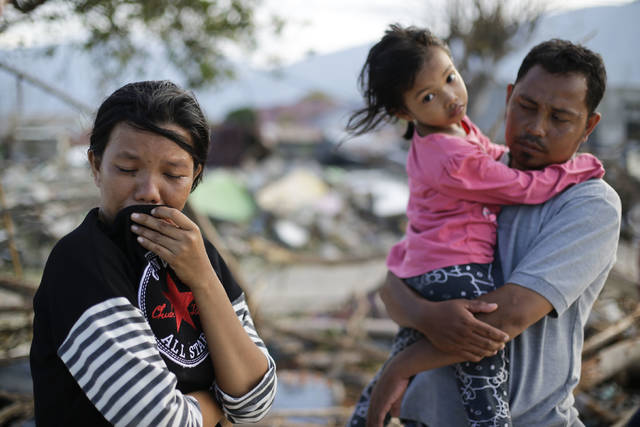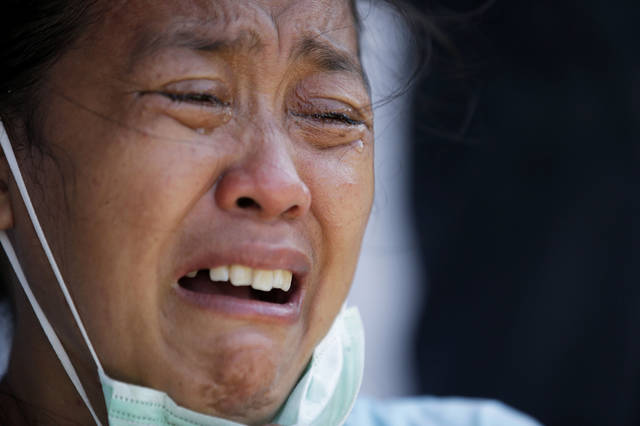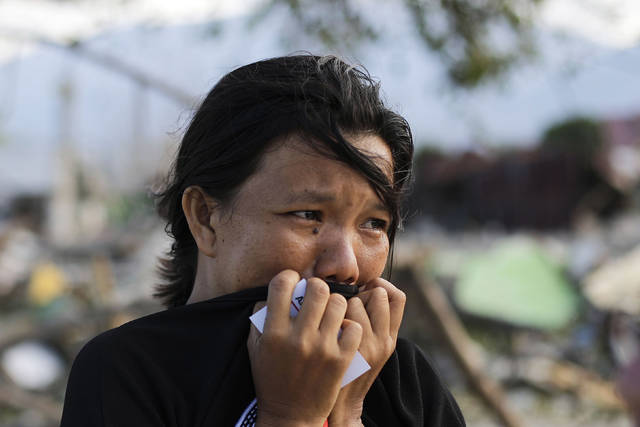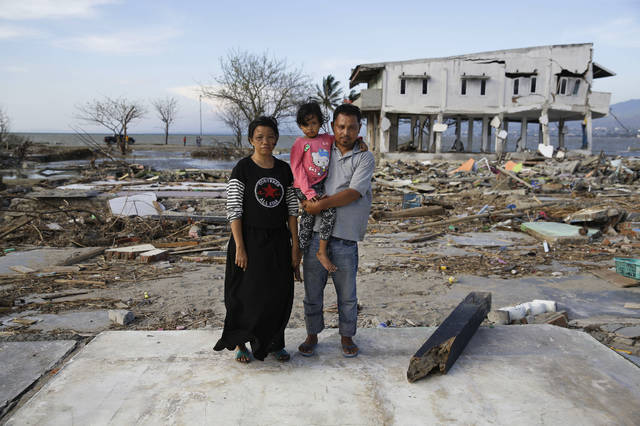10 minutes of terror: A quake, a tsunami and a missing son

In this Oct. 5, 2018, photo, Musrifah, left, cries beside her husband Hakim and daughter Syafa Ramadi as they visit the area where their house used to stand before a massive earthquake and tsunami hit their seaside village in Palu, Central Sulawesi, Indonesia. The family lost their son. The 7.5 magnitude quake triggered not just a tsunami that leveled huge swathes of the region’s coast, but a geological phenomenon known as liquefaction, making the soil move like liquid and swallowing entire neighborhoods. (AP Photo/Aaron Favila)

In this Oct. 6, 2018, photo, Aminah Gozah grieves after seeing the bodies of two of her three missing sons buried meters deep in the earthquake-damaged Balaroa neighboorhood in Palu, Central Sulawesi, Indonesia. She was home waiting for her three children to return for dinner when the disaster struck. None of them ever came home. (AP Photo/Aaron Favila)

In this Oct. 5, 2018, photo, Musrifah breaks into tears as she visits the area where her house used to stand before a massive earthquake and tsunami hit their seaside village in Palu, Central Sulawesi, Indonesia. The family lost their son. The 7.5 magnitude quake triggered not just a tsunami that leveled huge swathes of the region’s coast, but a geological phenomenon known as liquefaction, making the soil move like liquid and swallowing entire neighborhoods. (AP Photo/Aaron Favila)

In this Oct. 5, 2018, photo, Musrifah, left, and her husband Hakim, right, and their daughter Syafa Ramadi pose where their house once stood before a massive earthquake and tsunami hit their seaside village in Palu, Central Sulawesi, Indonesia. The family lost their son. The 7.5 magnitude quake triggered not just a tsunami that leveled huge swathes of the region’s coast, but a geological phenomenon known as liquefaction, making the soil move like liquid and swallowing entire neighborhoods. (AP Photo/Aaron Favila)
PALU, Indonesia — The Muslim call to prayer had just started echoing across the Indonesian city of Palu when Musrifah’s home shook violently.
PALU, Indonesia — The Muslim call to prayer had just started echoing across the Indonesian city of Palu when Musrifah’s home shook violently.
Photos fell from the walls. Dishes crashed down. A television smashed onto the floor, prompting Musrifah to scoop up her 2-year-old son.
Seconds later, the sides of their one-story house crumbled, filling the air with dust.
“Mommy!” the boy cried, trembling. “Don’t worry,” she told him. “I’m here.”
It was 6:02 p.m. on Sept. 28 and what followed over the next 10 minutes was a catastrophe remarkable even for disaster-prone Indonesia. The magnitude 7.5 quake triggered a tsunami and a geological phenomenon known as liquefaction, making the soil move like liquid and swallowing entire neighborhoods.
The disasters would kill nearly 2,000 people. Thousands more would go missing. Among them was Musrifah’s son, Bima Alfarezi.
Growing up on Sulawesi island, where Palu is located, Musrifah was used to the earthquakes that hit the seismically active region. Though they could be scary, they rarely caused severe damage.
After a 2004 tsunami killed 230,000 people in a dozen countries, more than half in Indonesia, the threat of deadly waves was well known. But Palu had not experienced one in Musrifah’s lifetime, and most people believed the city was safe because it sits at the base of a long, narrow bay shadowed on both sides by mountains.
When five foreshocks with magnitudes ranging from 4.8 to 6.1 shook the area over the course of several hours Sept. 28, Musrifah thought little of it. She had family visiting and dinner was soon to be served.
Then the big quake struck and within a minute, several neighborhoods in the city of 380,000 were obliterated and buildings across town collapsed. Cellphone towers buckled, knocking out communication, while the control tower at the airport crumbled as a plane took flight.
Although much of Palu still stood, chaos was everywhere.
At Musrifah’s home, close to the shore of Palu Bay, her family rushed onto a terrace only to find it blocked on all sides by rubble.
Still cradling her son, she thought the worst was over.
The shallow quake, however, had triggered a tsunami that was barreling down Palu Bay.
Cellphone video aired on TV showed the moment the wave’s long white crescent approached the shore.
A man filming the scene from a parking garage can be heard yelling to those below: “Tsunami! Tsunami! … Run! Go!”
When the wave crashes through the shore, it sweeps up homes, spins them around and smashes them into vehicles on a road.
Trapped on her shattered terrace, Musrifah had no idea what was happening. The sea had burst through what was left of her home. Her only thought was escape. She squeezed her son tighter as he repeated: “I’m scared, Mommy, I’m scared.”
Two minutes later, Musrifah heard another roar. She looked up toward the sky and glimpsed a wall of water above a palm tree.
Before she could blink, the wave smashed down on top of them. The crushing force of the tsunami ripped Bima away and spun Musrifah upside down in the churn.
By the time she freed herself from the wave, she had been carried a kilometer (half a mile) away.
She was alone.
Soaked and shocked, all she could do was call out: “Bima! Bima! Where is my Bima?”
Two kilometers (a mile) inland, as the earthquake began to shake the city’s Balaroa neighborhood, residents faced a different calamity, what many described as a tsunami made of soil.
As the ground cracked apart, mud and dirt moving like liquid erupted through chasms. The sludge created a swirling sea of mud that rose up and swallowed virtually everything in sight.
The phenomenon known as liquefaction occurs when loose water-filled soil near the surface loses its strength and collapses. In places in Palu, parts of entire neighborhoods were moved dozens of meters (yards) away.
“It seemed as though the ground was on a roller-coaster,” 56-year-old Balaroa resident Asran said.
Back along the shore, Musrifah made her way to a nearby mosque. It was there, just after midnight, when she was reunited with her husband Hakim and their daughter who had been out together before the earthquake.
They held each other and wept. Then Hakim asked the question Musrifah didn’t want to hear: “Where is our son?”
“I couldn’t hold onto him,” she said. “I’m so sorry. I couldn’t protect him from this.”
The next morning, the couple combed the area around their former home, now a flattened field of intertwined rubble.
For five days, they walked through wreckage, calling Bima’s name as crews pulled bodies from the debris.
They visited every hospital in the city, asking officials to unzip bag after bag containing the corpses of young children. There were too many to count.
None of them was Bima.
Then, at midday Thursday, something inside Musrifah told her to look in a mangled pile of debris not far from where their house once stood.
Almost immediately, she saw a little body pinned face down between a gas canister and a shredded pile of wooden beams. He was wearing a dark gray shirt and turquoise pants, just like Bima was when the tsunami snatched him from her arms.
His bloated body had decomposed so much, though, it was not possible to recognize his face. But when she saw the blue sandals on his feet, she was sure. It was him.
When an emergency crew placed him in a body bag an hour later and zipped it shut, Musrifah did something she had dreamed of, and dreaded, for almost a week.
She put her arms around her son, and hugged tight.
———
Associated Press journalists Niniek Karmini and Andi Jatmiko contributed to this report.

